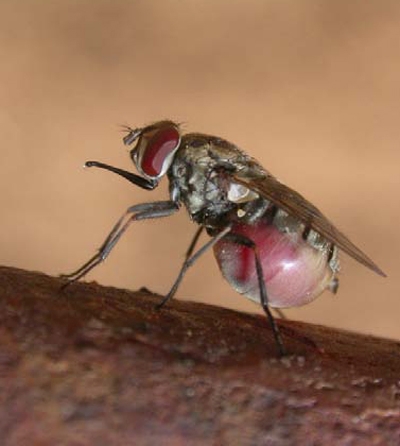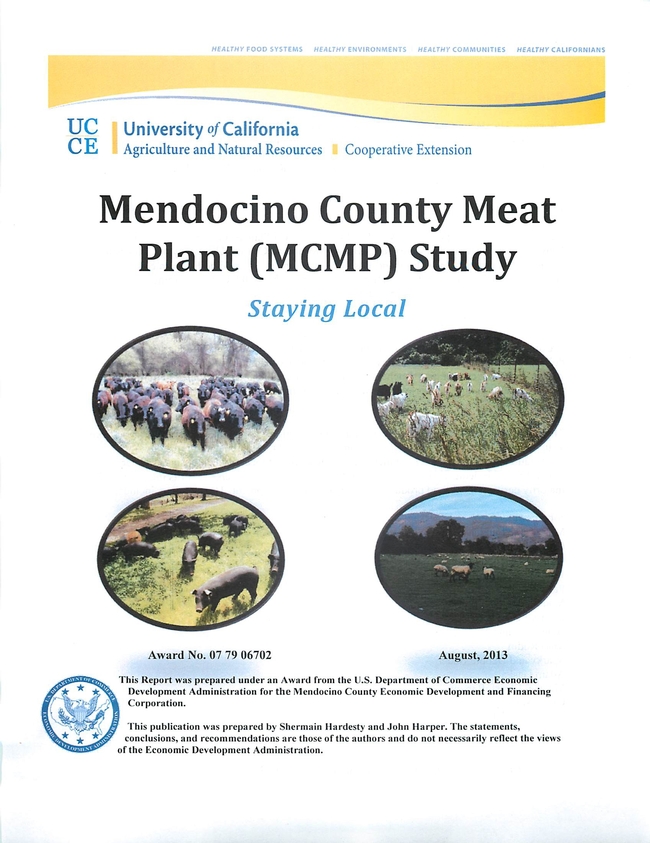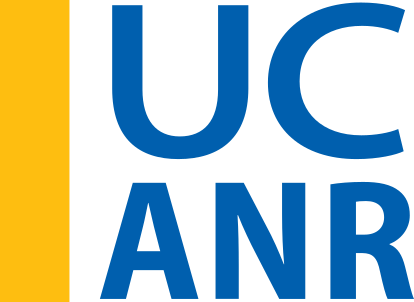- Author: John M Harper
Great News!
Ken Tate has agreed to expand his presentation at the upcoming California Ranch Stewardship Workshop on October 21 from 1- 4 pm at the Farm Advisors' office! His presentation is entitled Research Update: Grazing and
Environmental Topics. This is a very timely subject as Ken will be highlighting new research that has focused on water quality, sensitive species conservation and riparian health – important to both Mendocino and Lake County ranchers as they deal with on-going regulations. Ken will provide the science that landowners need to be informed when dealing with regulatory agencies. You don't want to miss it!
Remember. Preregistration ($15) is required either by credit card, check or cash at our web site at: http://ucanr.edu/survey/survey.cfm?surveynumber=13795 to ensure we have sufficient handouts and refreshments (We've had numerous requests for Schat's cookies.). If you'd like to pay by check or cash contact our office and talk to either JT or Tanis. (707) 463-4495.
Hope to see you there!
CA Ranch Stewardship Workshop
- Author: John M Harper
November 7, 2014
• What the U.S. Drought Monitor means to you
• How CA Ranchers are coping with the drought
• New feeding strategies for livestock in drought
• NOAA's forecast for the coming season
The map tells the tale of California's relentless drought, its location and severity. This workshop will tell you the story of the Drought Monitor, in particular how the map may help you qualify for drought relief assistance – and how local California experience and information can be used to inform the drought mapping process. Results will also be shared from current studies of how ranchers are impacted by and managing for drought on their ranches, as well as on the newest livestock drought feeding strategies. The California state climatologist will present the forecast for the coming season. The workshop will be on the UC Davis campus and webcast to the majority of participants at local satellite locations across California. The workshop recordings will be posted on-line.
Questions and comments from local satellite webcast locations will be included throughout the workshop.
Agenda
| 9:15 AM | Registration Opens and Morning Refreshments Served | |
| 9:50 AM | Welcome, Ken Tate, UC Davis and UC Cooperative Extension | |
| 10:00 AM | U.S. Drought Monitor: Setting the Context and Introduction of Speakers, Mark Svoboda, National Drought Mitigation Center | |
| • A Behind the Scenes Look at the Drought Monitor: History, Tools, and Methods, Eric Luebehusen, USDA | ||
| • How to get information into the US Drought Monitor Process, Brian Fuchs, National Drought Mitigation Center | ||
| • The California Drought of 2011-14: Brief History and Current Impacts, Brad Rippey, USDA | ||
| 11:00 AM | Questions and Discussion about the Drought Monitor and California, Chad McNutt, NOAA Discuss the Drought Monitor and how California's ranching and range community can inform the process. |
|
| 12:00 PM | Lunch Provided by the UCD Rustici Rangeland Endowments | |
| 1:00 PM | California Ranchers' Experiences with Drought, Leslie Roche, UC Davis Insights to on-ranch drought impacts, outlooks, and management based on surveys and interviews of over 500 ranchers living through this drought. |
|
| 1:30 PM | New Livestock Drought Feeding Strategies, Glenn Nader, UC Cooperative Extension Tips for improving the nutritional quality of low quality feed products, and supplementing livestock diets on rangelands. |
|
| 2:00 PM | Seasonal Climate Forecast and Opportunity for Q&A's for the Coming Season, Michael Anderson, California State Climatologist, California Department of Water Resources | |
| 2:30 PM | Closing Remarks, Tim Koopmann, President, California Cattlemen's Association |
Contact for Information and Registration – Tracy Schohr at tkschohr@ucdavis.edu or (916)716-2643(916)716-2643
Workshop and Webcast Locations – UC Davis campus and webcast to Auburn, Ventura, San Luis Obispo, Bakersfield, Tulare, Merced, Ukiah, Redding, Susanville, Yreka – more locations and details coming soon.
Useful Links
U.S. Drought Monitor – http://droughtmonitor.unl.edu/
U.S. Drought Monitor California– http://droughtmonitor.unl.edu/CA
UC Rangeland Watershed Laboratory Drought Page – http://rangelandwatersheds.ucdavis.edu/main/drought.html
- Editor: John M Harper
- Author: Alec Gerry

Insect Pests of Animals: Searchable Pesticide Database
The UC Riverside Veterinary Entomology Extension Laboratory has developed an on-line database of pesticides registered in the State of California for use against arthropod pests of animals. The database can be found at: http://veterinaryentomology.ucr.edu/vet_pesticides.html Website visitors can search by animal commodity for which pest control is needed (e.g. poultry), by type of pest (e.g. poultry mite or house fly), and by application method and formulation. It is expected that animal producers and extension personnel will find this database to be much easier to navigate than the California Department of Pesticide Regulation product search website.
Animal producers may also be interested in other offerings of the Insect Pests of Animals website (http://veterinaryentomology.ucr.edu/). Visitors can find pest management information for some ectoparasite pests of poultry, cattle, and other animals. We are adding information on additional pests every few months so be sure to check back to see what has changed. We also maintain a Blog (http://veterinaryentomology.ucr.edu/blog/) that producers and extension personnel may be interested to follow. Information shared through the Blog includes recent findings related to pest management in animal facilities or of general relevance to animal producers, extension personnel, and researchers.
Finally, animal producers may be interested in taking a look at the many web links provided in our “other resources” section. In particular, there are links for producers to submit animal management questions to the national eXtension program through their “Ask and Expert” program. Experts from universities, extension offices, private industry, and other relevant organizations are registered with this national eXtension program to answer submitted questions or to provide question writers with guidance to address their questions.
If you have comments about or suggestions for our Insect Pests of Animals website, please send these to me at:
Alec C. Gerry, Ph.D.
Associate Professor and Extension Specialist (Veterinary Entomology)
Department of Entomology
University of California
Riverside, CA 92521
http://www.entomology.ucr.edu/faculty/gerry.html
(951) 827-7054

- Author: John M Harper
The University of California Agriculture and Natural Resources created a call in January of 2014 for new UCCE Advisor and Specialist positions. The goal for filling these positions is to strengthen and rebuild the UC ANR network to meet programmatic gaps and emerging issues facing California identified in the Strategic Vision (see: ANR Strategic Vision 2025 full report or ANR Strategic Vision 2025 Executive Summary) and further refined in each of the 5 Strategic Initiatives entitled: Endemic and Invasive Pests and Diseases, Healthy Families and Communities, Sustainable Food Systems, Sustainable Natural Ecosystems and Water Quality, Quantity and Security. All 123 new proposed positions are listed on a public web page at this link.
These proposed positions are presently undergoing internal review until August 18, 2014. The public is invited to comment on these proposed positions until July 21, 2014.
Of the 123 positions proposed, 23 positions could benefit California's livestock, forestry and natural resources based industries. Those same 23 positions would have overlapping impact on both sustainable natural ecosystems, water quality, quantity security and sustainable food systems. I have listed in the table below those 23 positions with their identifying number, title, type of position (Advisor or Specialist) and where those positions would be located. Area Advisors are housed in one county but cover multiple counties. Specialists are statewide and support Advisor research and educational programs. If you click on the ID Number it will take you to the page where you can add comments for that position. There is also a link on that same page that describes the position in more detail.
|
ID Number |
Position Title |
Advisor or Specialist |
Location, County or Campus |
|
Area Livestock & Natural Resources |
Advisor |
Tuolumne |
|
|
Area Desert Livestock |
Advisor |
Imperial |
|
|
Area Forest & Natural Resources |
Advisor |
Ventura |
|
|
Area Forest & Natural Resources |
Advisor |
Sutter-Yuba |
|
|
Area Livestock & Natural Resources |
Advisor |
Placer-Nevada |
|
|
Area Livestock & Natural Resources |
Advisor |
Sutter-Yuba |
|
|
Area Livestock & Natural Resources & Community Development |
Advisor |
Plumas |
|
|
Area Livestock & Natural Resources |
Advisor |
Ventura |
|
|
Area Natural Resources – Fire & Restoration |
Advisor |
San Diego |
|
|
Dairy |
Advisor |
Sonoma |
|
|
Dairy |
Advisor |
Humboldt |
|
|
Livestock & Natural Resources |
Advisor |
Siskiyou |
|
|
Applied Limnology (Lakes & Fresh Water) |
Specialist |
UCD |
|
|
Aquaculture |
Specialist |
UCD |
|
|
Beef Cattle Herd Health |
Specialist |
UCD Vet Med |
|
|
Dairy Cattle Production Health Management |
Specialist |
Vet Med Teaching & Research Center -Tulare |
|
|
Forest Products and Woody Biomass |
Specialist |
UCB |
|
|
Livestock & Rangeland Economist |
Specialist |
UCD |
|
|
Plant Conservation |
Specialist |
UCR |
|
|
Rangeland Management |
Specialist |
UCD |
|
|
Rangeland Policy & Planning |
Specialist |
UCB |
|
|
Rangeland Ruminant Nutritional Ecology |
Specialist |
SFREC Sierra Foothill Research & Extension Center |
|
|
Sheep & Goat Heard Health & Production |
Specialist |
UCD Vet Med |
It is very possible that not all of these positions will survive the screening process. That's why it's important to have stakeholder input and I urge you to take the time to review at least each of these and comment. Please also comment on any of the other positions shown on the full list as well.
It's also important to know that the comment process is not a voting one. Rather it is a supportive process from stakeholders who are visionary and statewide-thinking about the issues facing California's livestock and natural resources owners, managers and stewards. Some of these positions, especially the Advisors and a few of the Specialists, have had very successful people filling those slots. The public comments should not focus on replacing one of these great people but local, regional and statewide need for the position to work to solve current and future problems.
As the statewide leader for the Sustainable Natural Ecosystems Initiative, I would also like to hear from my blog readers how you might rank the positions in the above table outside of the comments you provide on the public page links I've provided in the table. To do so just either comment on this blog article, message me via LinkedIn or Facebook or drop me an email at jmharper@ucanr.edu. Please put SNESI positions in the subject so I can search and sort. I look forward to hearing from you!
- Author: John M Harper

The report was prepared under an Award from the U.S. Department of Commerce Economic Development Administration for the Mendocino County EDFC. The study authors were Shermain Hardesty, Cooperative Extension Specialist, UC Davis Department of Agricultural and Resource Economics and John Harper, UCCE Livestock & Natural Resources Advisor for Mendocino & Lake Counties.
The study examined a proposed project for a small-scale multi-species USDA-inspected meat plant that would primarily serve ranchers in Mendocino and Lake Counties. The plant would handle cattle, hogs, sheep, goats and bison. It is different from most niche meat plants because most of the ranchers interested in using the facility already have established markets, primarily in the North and East Bay. Those ranchers would be shifting their harvest and/or processing from one or more existing facilities (none are located in Mendocino or Lake Counties) to the proposed meat plant.
The study and report included an Analysis of Demand for USDA-Inspected Slaughter & Processing Services; Alternative Organizational Models; Alternative Sources of Financing; Plant Requirements, Options and Siting; and Financial Analysis of Three Options.
The three plant options analyzed were: Option A - provides only cut-and-wrap services using a modular processing unit and a trailer office located in an industrial park with a total cost of $430,500; Option B - includes the same processing facility and trailer office described for Option A, plus a modular slaughter unit and adjacent holding pens located at a leased site on an unspecified ranch with a total cost of $821,100; and Option C - a built-in-place 2,400 square foot harvest and processing facility located on purchased property with a total cost of $1,425,516. All options have a capacity to handle 1,500 equivalent animal units (1 steer = 2 hogs = 2 lambs or goats) per year or 30 equivalent animal units per week. The plant would operate in a 50-week year with a single 8-hour per day shift.
All three options proved to be financially viable. Option B has the highest Internal Rate of Return (IRR) of 11.1%. Option C's IRR is 6.6% and is impacted significantly by the purchase of 3.7 acres for $483,516. Option A's IRR is 3.9% but since it is cut-and-wrap only, it does not meet the needs of the ranchers doing direct marketing. Ten-year cash flow for Option C is included in the report.
A public meeting will be held on September 5, 2013 at 5 pm in Ukiah to present the report and answer questions. The meeting will be held at the Sun House Public Meeting Room. The room is on the west side of the Grace Hudson Museum, located at 431 S. Main Street.
Next steps include that authors Hardesty and Harper will prepare a business plan for implementing Option C for the EDFC.



